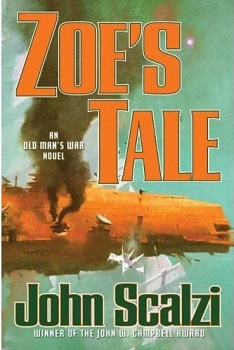
Zoe’s Tale
John Scalzi
406 pages
published in 2008
John Scalzi’s Old Man’s War was popular enough to spawn four sequels so far, of which Zoe’s Tale is the third. Military science fiction set in a Heinleinian dog eat dog universe, with hundred of alien races competing for new colonies and humanity only a middling power, the first three novels in the series followed new recruit John Perry and Special Forces specialist Jane Sagan through increasingly high stakes adventures, in the process learning that the Colonial Defence Forces they’re fighting for might not be entirely trustworthy. Things came to a head in the third novel, The Last Colony in which John and Jane, as leaders of the latest colony founded by the CDF had to fight off the Conclave, a four hundred members strong alien alliance as well as the CDF’s own plans to turn the colonists into martyrs. Amongst those colonists? Their own, adopted, daughter Zoë.
As you may have guessed from the title, Zoe’s Tale retells and extends the story of The Last Colony from Zoë’s point of view. On its own it’s therefore slightly less than a whole novel and can only be properly understood if you’ve read the previous novel. Things happen for reasons that are only partially explained, with major plot developments happening off screen, “as you know bobbed” later; at the same time Zoe’s Tale was partially written to explain some of the plot holes from The Last Colony. For me, it had been more than two years since I’d read it, so some of its plot was a bit hazy while reading this; not entirely dissimilar to Zoë’s experiences.
Zoë is the seventeen year old daughter of a defeated adversary, not just adopted by John and Jane, but also the living symbol of Earth’s treaty with the Obin, an alien species with intelligence but no consciousness, until her natural father created a device to give them consciousness artificially. As a consequence Zoë is accompanied at all times by two Obin bodyguards and friends of the family, Hickory and Dickory. One of the main plot threads in the book is her continuing discovery of how much she means to the Obin and the consequences this has for her.
Zoe’s Tale is told entirely through her eyes, first person. Having a fortysomething male writer write from a teenage girl’s perspective is always tricky but fortunately for all his Heinleinian influences Scalzi is much better at writing female characters than he ever was. Not that Zoë is entirely believable: she’s far too reasonable, obedient and mature for her age, unless the plot demands otherwise. Granted, she’s of course not quite the average teenage girl, what with that whole Obin thing, but despite this it still felt a bit off to me.
The novel starts with Zoë and her family coming to their new colony homeworld, then discovering not everything is as it seems and that they’re going to function as bait, though it takes a while for that to become common knowledge. A large part of the story is taken up with Zoë’s adventures on the journey to the new colony and her experience in it, before the Conclave come. This feels somewhat jumbled and episodic and things seem to happen because they happened in The Last Colony rather than flowing organically from the plot. As said, Zoë remains unaware or is only told later about major developments, while in the previous novel you were right there.
Two of the plotlines however are exactly the opposite, showing the details of things only sketched in in The Last Colony, viz what happened with the “werewolf” like aborigines that turned out to live on the planet, as well as the story of how Zoë escaped from the colony to seek help amongst the Obin. These are the strongest sections of the story and the places where Zoë comes to the fore, an active participant rather than an observer.
In the end Zoe’s Tale was a decent enough read, but only because I’d already read the previous novels, if several years before. It’s somewhat weaker than them, largely due to the fact that this was partially intended to repair some of the plot holes in the previous novel.
No Comments